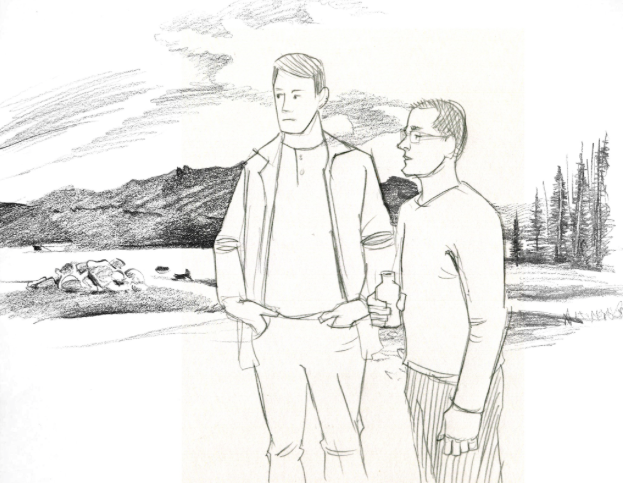One of the biggest challenges in drawing and sketching is tackling background space. Often times we get caught up in the foreground and ignore or only half-heartedly realize a successful background for our foreground imagery to occupy. A strongly drawn or sketched background can provide necessary context for what’s happening in the foreground, and can add visual interest to keep the viewer’s eye moving and examining the image. And pencils are a robust but forgiving medium that provide the flexibility to explore these background environments.
Without getting into the rules of perspective, there are still a few things to remember when considering how to depict background space realistically. Most of these you know without thinking, and so does the viewer, but it’s easy to forget about some of these rules when sketching a background.
- Overlap: How objects overlap other objects in the picture determines how the viewer understands the space. Anything overlapping or partially obscuring something else will appear closer to the viewer
- Relative Scale: Obviously, things that are bigger will appear closer, especially in comparison to a smaller version of the same kind of object.
- Relative Position: This may be less intuitive than the previous two concepts, but things that are lower in the picture appear closer. Things that are higher seem farther away.
- Dark vs Light: Dark objects usually appear closer and light objects usually appear distant. This is a real phenomenon in nature known as atmospheric perspective. It’s the reason far-away mountains are a light, hazy blue, while closer mountains and other objects are darker and retain more contrast. The pencils you choose can enhance this effect– hard pencils in the H range are lighter, while dark pencils in the B range are darker.
- Horizon: The horizon is always the same as the viewer’s eye level. You can place the horizon wherever you want in a drawing, but it determines the viewer’s eye level. So anything placed above the horizon line is above the viewer. Correspondingly, anything below the horizon is below the viewer. So unless you want the viewer to think he’s floating in a hot-air balloon, you’d better make sure that street lamp extends above the horizon.
Here’s a pencil sketch of two cool dudes standing next to each other. But with no background, there’s no context; nothing to suggest a location or narrative.

But if we add an apartment building behind them, something happens.

Now, their world becomes more real for the viewer. Carefully observed details enhance the image. It’s not just a building, it looks like an old Art Deco building. The pickup truck looks like an F-150. These details give verisimilitude, or realism, to the drawing. This feels like a real place. And their location also lends itself to building a narrative. Why are these two men on the street? What are they seeing?
What if we add a different background?

Camping trip? Lost in the wilderness? The narrative possibilities fly out at the viewer.
Most important to a realistic pencil background is research. Seek out specific environments and details– find the right tree or car or building for that space. Marshal your resources so you have them at the ready- keep files of images and go and seek out the real thing whenever possible to draw from. These will help keep your backgrounds from looking like an afterthought or too generic, and keep the viewer engaged. A good drawing is only as strong as its weakest element. A strong foreground can’t save a weak background, and vice-versa, but if both are strong and can hold somebody’s interest, you’ve succeeded.
Share tips, start a discussion or ask one of our experts or other students a question.
No Responses to “Sketching Pencil Backgrounds: 5 Steps to Success”